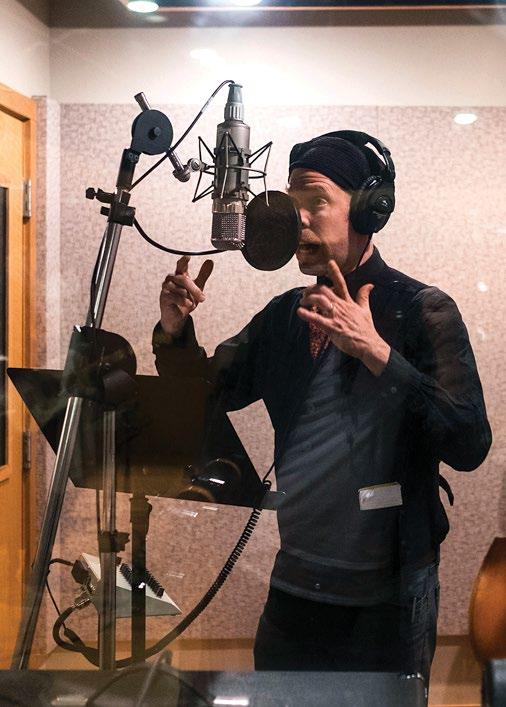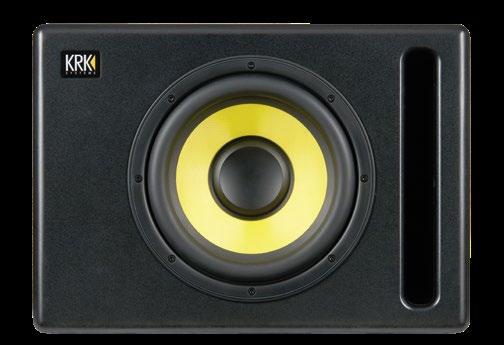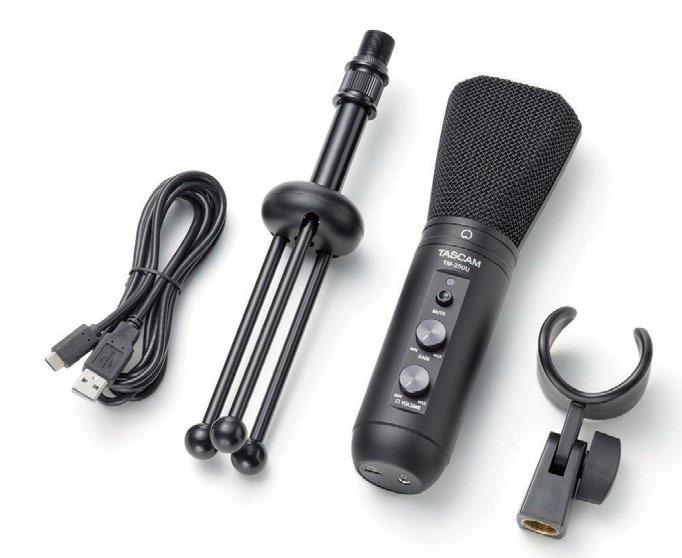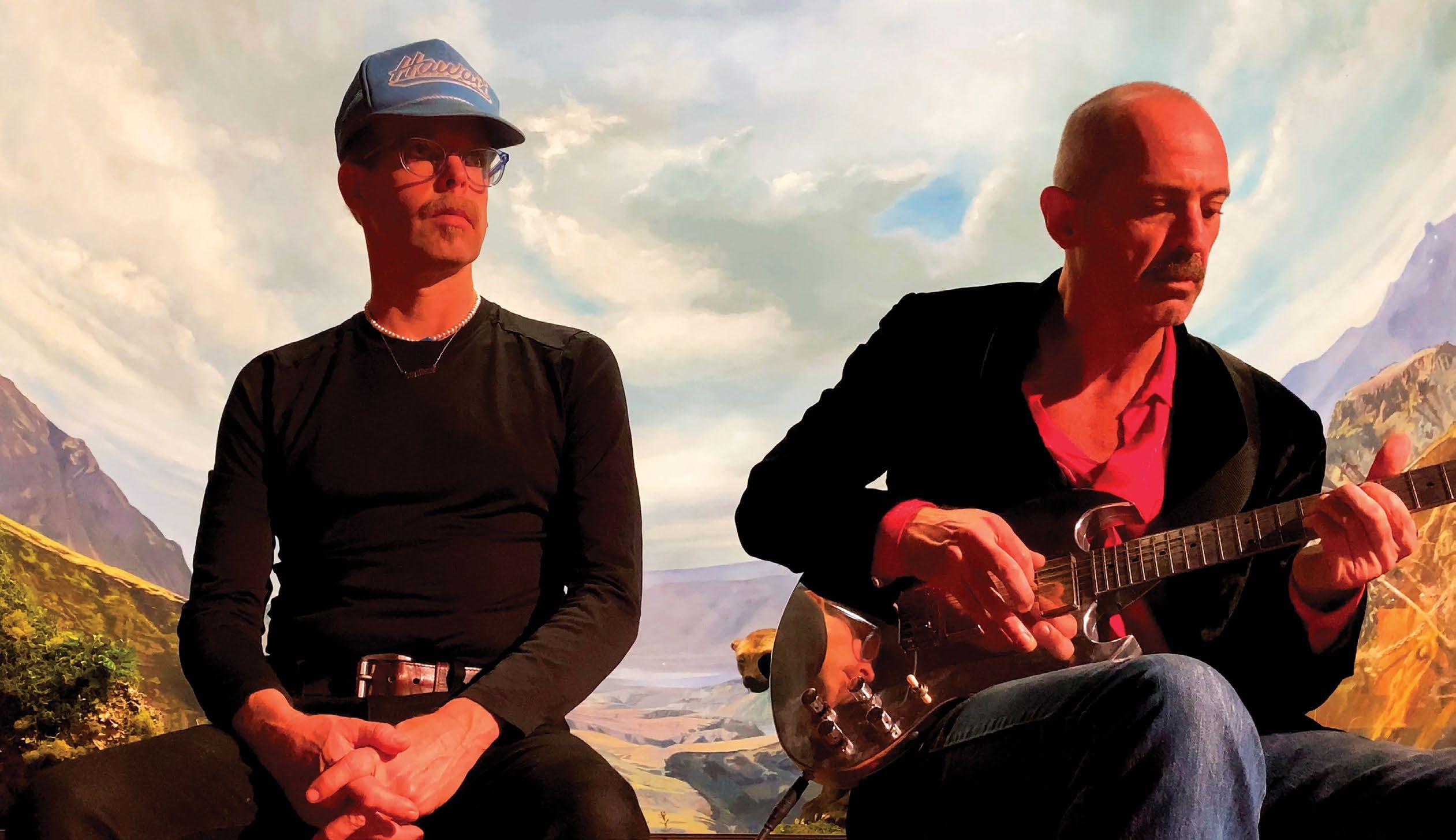
11 minute read
Superwolves
from MIX 533 - May 2021
by publications
Music
Bonnie “Prince” Billy, left, and Matt Sweeney
Superwolves
Matt Sweeney and Bonnie “Prince” Billy’s Cult Classic Project Returns
By Barbara Schultz
It’s a follow-up album almost 15 years in the making, or at least waiting.
Guitarist Matt Sweeney and singer/ songwriter Will Oldham (known as Bonnie “Prince” Billy) made their starkly resonant Superwolf (Drag City) album in 2005, and it became a favorite of critics, college students, and any music lovers with catholic tastes. Fans wondered if the duo would do more. Their wait is finally over, as April 2021 sees the release of Superwolves (Drag City), which expands on the reverberant guitar-and-voice sound of Superwolf.
“We’re just, as a duo, slow,” says Oldham. “We began work on these songs in something resembling earnest in 2015.”
Their songwriting process starts with Oldham, who lives in Kentucky, writing lyrics and sending them to Sweeney in New York. After Sweeney composes the music, the two will come together to play, first privately and then in some public setting.
“We’ll play someplace like a record store, and by the time we’re done with that we’re ready to go into the studio and let it fly,” says Sweeney. “But there’s a tremendous amount of work that goes into letting it fly. It’s like getting ready for the biggest show of your life. You work and work and work, and then when you go into the studio, that’s the show.”
The studio work started in fall of 2019 in Daniel Schlett’s Strange Weather studio in Brooklyn.
“I met Daniel at a show a couple of years ago,” Sweeney says. “Charlie Sexton was in town, and I took Charlie to see Mdou Moctar. Daniel happened to be there with some mutual friends,
and we started chatting. Daniel is a sort of highenergy New Jersey guy like me, and we hit it off. We exchanged numbers and then we started emailing each other music that we like—African music and psyche music and whatnot.
“Then an opportunity presented itself to do some recording with Will and Mdou Moctar, so we went to Daniel’s and everything went so great,” he adds. “I’d been looking for an engineer who I could work with in New York because I also produce records, but I’m a total Luddite. I’m good at recognizing good performances, but gear isn’t my thing.
“Daniel has all of that, but I also find him to be very performance-oriented. His studio is gorgeous and so work-focused. It’s funny because everybody knows where that studio is, but nobody knows it exists. It’s on a busy street, but when you walk in, it’s a complete, beautiful world unto itself, and very classically, a studio.
“I recorded there with Iggy Pop, and when he walked in, he goes, ‘This is a real studio!’” Sweeney continues, doing an excellent Iggy Pop impression. “He was like, ‘This reminds me of how studios used to be. It’s like Criteria in Miami!’”
LIVE AT STRANGE WEATHER The Superwolves recordings started with live duo sessions in Schlett’s main tracking room.
“The first day or two was just those guys capturing songs, some acoustic and mellow and some of them with Matt’s electric guitar,” Schlett recalls. He captured Oldham’s vocal with a vintage Neumann U47 into a Neve 1070 mic preamp. Sweeney’s guitar amp was miked up with a U67 into an ADL 670 or UREI Silver 1176 compressor/limiter.
“The ADL 670 would have been used on the vocal. Will’s vocal is the only thing I put through a Neve pre,” Schlett says. “Everything else went through the pre’s in our API Legacy console.
“It was the third day or so when Mdou’s band showed up at the studio,” the engineer continues. “I had Matt and Will set up in the middle of the big live room, so I put the drums in front of them and set the band up in a circle around the existing setup. I used a couple of gobos, and I stuck some amps in the corner—tried to space it out as much as I could, because we had everybody in one room with no isolation except for headphones.”
Mdou Moctar and rhythm guitarist/producer Ahmoudou Madassane appear on the up-tempo song “Hall of Death.” On a few other songs, guests contribute keyboards, drums or bass.
“With everything coming so quickly, live off the floor, there’s no time for 14 mics on the drums, for example, so I just had a Neumann U48 in front of the kit, a [Shure] SM57 for snare, and an AKG D20 outside mic,” Schlett says.
Moctar’s guitar was captured similarly to Sweeney’s. Some of the bass parts were overdubbed because Sweeney played them, but on the full band track “Hall of Death,” Mikey Coltun played live with the band.
“He played through an Ampeg B15, and that was probably miked with a 421 or a Neumann M49. I really like those on bass, especially in a live setting,” Schlett explains.
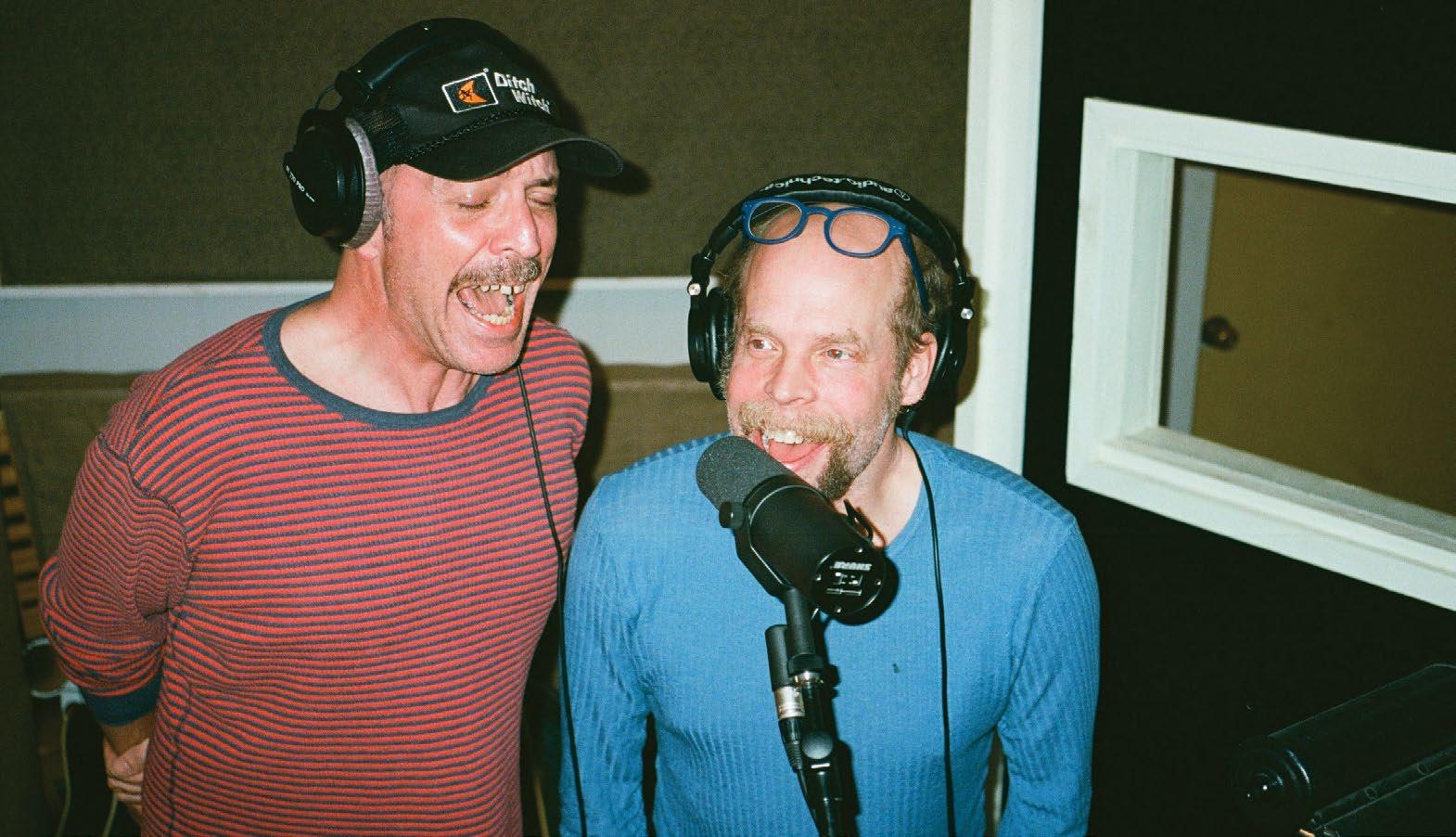
ON TO THE BUTCHER SHOPPE Of the 14 songs on Superwolves, Sweeney and Oldham cut five at Strange Weather. They then went back to writing material before decamping to David “Ferg” Ferguson’s The Butcher Shoppe studio in Nashville. That studio actually closed this past June, but in previous incarnations had been owned by Cowboy Jack Clement, and by Ferguson with the late, great John Prine.
“I met Ferg working on Johnny Cash records,” Sweeney says. “I got brought in as the new guy in the mix with all of Rick Rubin’s Johnny Cash Circle. I have to say, the second I walked into the studio with them, I knew that Ferg was really the ears there. Ferg worked with Johnny Cash for the last 20 years of his life. He had worked with Johnny for so long and had watched him die and they wanted to make those posthumous Johnny Cash/Rick Rubin records like real love letters to Johnny Cash and that relationship with Ferg and those musicians.”
The relationship Sweeney forged with Ferg brought him to The Butcher Shoppe time and again over a period of 13 years. Superwolves marked his and Oldham’s final visit to the studio, and one of the last sessions to take place there, under the guiding light of Ferg and his longtime engineer Sean Sullivan.
Just about everything that happened in The Butcher Shoppe went down live. “I like it when an engineer defaults to live, same-room recording rather than separation/isolation, especially when they don’t make it a ‘thing’ to proceed that way,” says Oldham. “At no point in working with Ferg or with Daniel did I feel like they thought we should go for something preexisting; they’re more than happy to sit back, let the music happen and then make decisions based on what the music calls for.”
Engineer Sullivan recalls the setup in The Butcher Shoppe’s 20x25-foot live room: “Whether the song was acoustic or electric, Matt ran everything through two guitar amps. One was an old Musicman that he’s had for forever. It has this weird built-in phaser that’s very resonant, with this nasally whoosh to it. The other amp was from an old Bell & Howell photo projector that got turned into an amp, and that thing had more of a blown-out sound.
“The amps were in a separate room about 10 feet away from where Matt was sitting in the cutting room. We would take those two amps and a DI also, so there were three lines and the tracks have sort of a blend of those things.”
Oldham sang into a Shure SM7, through a Daking Mic Pre/EQ. “I don’t remember if I used any of the EQ while tracking,” Sullivan says. “But I like using something with an option of a little EQ just in case it’s a little dark or muffled.
Vocals at the Butcher Shoppe
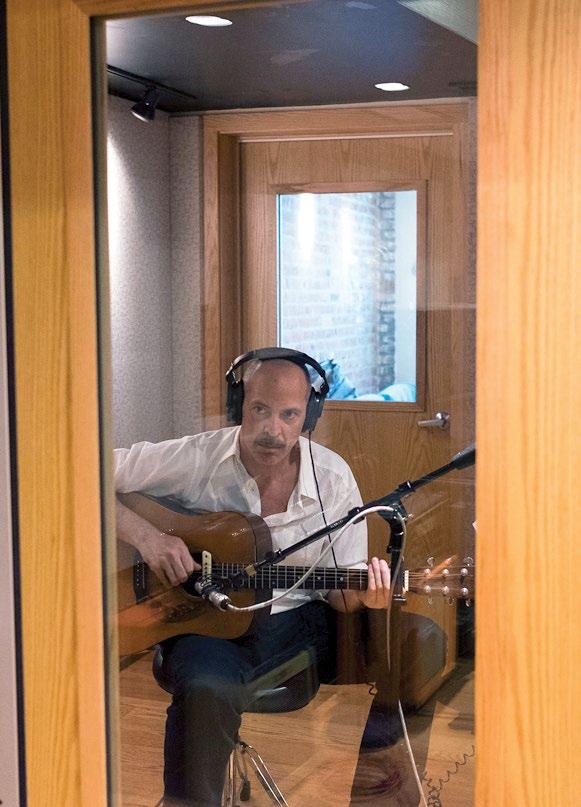
“The vibe was very like ’60s folk in that the guitar playing matches the melody of the singing,” Sullivan continues. “So, it was important for them to be able to see each other. When Matt played acoustic guitar, we just plugged it in, put a mic on it, so it was the same setup. A lot of those songs are just one guitar and voice, maybe some harmony, but they’re really sparse.”
A few of the songs did include additional live instrumentation, provided by drummer Pete Townsend and/or keyboard player Mike Rojas. Later, a couple of bass parts and some harmony vocals were overdubbed by Ferguson, ever humble about his role in the studio. “Sean carried the weight on the engineering. I was there for moral support and to lend a hand however I could,” Ferguson says. “I PHOTO: Christian Hansen Bonnie "Prince" Billy recording vocals at Strange Weather Sweeney in Strange Weather, Brooklyn recommended they use Mike Rojas, but I’m not property were incredibly generous to us. When mixed the tracks he had recorded, with Sweeney the hero here.” you consider what Nashville real estate is like sitting in with Schlett, and Oldham at the Butcher
Sullivan captured Ferguson’s bass parts on now, they could have sold it a lot sooner.” Shack with Sullivan, who recalls he didn’t use a lot the songs “Resist the Urge” and “There Must Be “It sucks,” Sweeney says, less charitably. of compression or EQ on his part of the project, a Someone” with a Neumann TLM103 placed “When I think about it, I get that weird, but the reverbs he employed are the plate from near on the low end, and a KM84 on the upper overwhelming feeling that you get when you’ve the Opry and/or an AKG BX10 spring. fingerboard. lost something that you really care about and Schlett also has an EMT 140 that he employed
“Sean had everything set up in the main you go, ‘I can’t think about that.’ But at the up in Brooklyn. “One other thing that we used on tracking room so we could all play together if we same time, the two things I love about Nashville Will was a Collins 26-C that we built years ago,” wanted to, but we did it as an overdub because are staying at Ferg’s house and going to The he says. “That was elemental in getting the vocal I didn’t know their songs nearly as well as them Butcher Shoppe. Now The Butcher Shoppe is clarity that we were looking for. There were a and I didn’t want to mess a take of theirs with gone, but Ferg still lives on this incredible kind bunch of other things that I used on his vocal— mistakes,” Ferguson says. of compound in the country. And he just moved parallel compression, vocal bus compression—but
His backing vocals on “There Must Be the studio there.” when I used the Collins I remember Matt sitting a Someone,” captured via the same SM7 that Ferguson calls his new studio the Butcher on the couch, perking up and saying, ‘What’s Oldham used, happened almost by accident “I was Shack. It’s a smaller studio—more suitable for happening now? Will sounds really great now.’” just singing along to it out in the control room,” mixing and overdubs than live recording—but In fact, Oldham and Sweeney both sound Ferguson says, “and they said, ‘You want to put there’s no commute, and Ferguson and his gear great, and they’ve finally granted fans’ wishes, that on there?’” are still going strong. thanks to a process where musical and personal “Right after we had to move out, Ferg had trust led the way. THE END OF AN ERA everything moved up to a little building on his “I’m incapable, with my present bag of tricks, Oldham and Sweeney’s recording sessions in property,” Sullivan says. “We had moved the [Sony of making anything that could approach the The Butcher Shoppe took place during mid- 3036] console, the Pro Tools HD rig, Dynaudio beauty or rockingness of what Matt can build, February of 2020. Just a few weeks later, the monitors, and we have an EMT 140 plate reverb musically,” Oldham observes. “In turn, I have a studio was closed temporarily by Covid-19. In that came from the Grand Ole Opry that we handle on creating lyrics and singing them that June, Ferg’s landlords sold the building, shutting bought after the flood in 2010. I think I got is not even on the property of Matt’s wheelhouse. the facility down once and for all. everything working the day before Will came.” And yet we value, to the point of appreciating the
“It was a somewhat fitting time for it to end, cruciality, the role each other’s domains play in with John Prine passing away,” Sullivan says. “We MIX WHAT YOU RECORD the creation of a musical world. It’s a relief when had an incredible run and we were fortunate to The mix in Nashville occurred simultaneously each of these songs gets realized; each is a little be there as long as we were. The owners of that with the mix phase in New York. Each engineer dream come true.” ■
